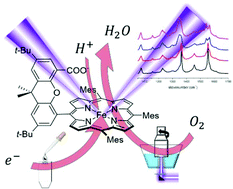Surface enhanced resonance Raman spectroscopy of iron Hangman complexes on electrodes during electrocatalytic oxygen reduction: advantages and problems of common drycast methods†
Abstract
Drycast methods have been used frequently in recent decades to adsorb a range of synthetic catalysts on electrodes. The uncoordinated multilayers that are formed via this immobilization method can however have a strong impact on the electrocatalytic reaction pathway as slow electron transfer and intermolecular interactions can alter the chemistry of the catalysts on the surface. To gain insight into the structure of Fe porphyrin Hangman catalysts during electrocatalytic oxygen reduction a combination of electrochemistry and surface enhanced resonance Raman spectroscopy (SERRS) was applied. The Hangman complexes were attached to the electrodes via different methods and the influence of the immobilisation technique on oxygen chemistry was studied. In multilayer systems, new intermediates could be identified via potential dependent SERRS that were not present in solution or in monolayer systems under catalytic conditions. A comparison of Raman spectra obtained either via Soret or Q-band excitation showed that the porphyrin symmetry is strongly distorted under reducing conditions, which was interpreted by the transient formation of dimer complexes during catalysis.

- This article is part of the themed collection: Frontiers in Spectroscopic Techniques in Inorganic Chemistry


 Please wait while we load your content...
Please wait while we load your content...